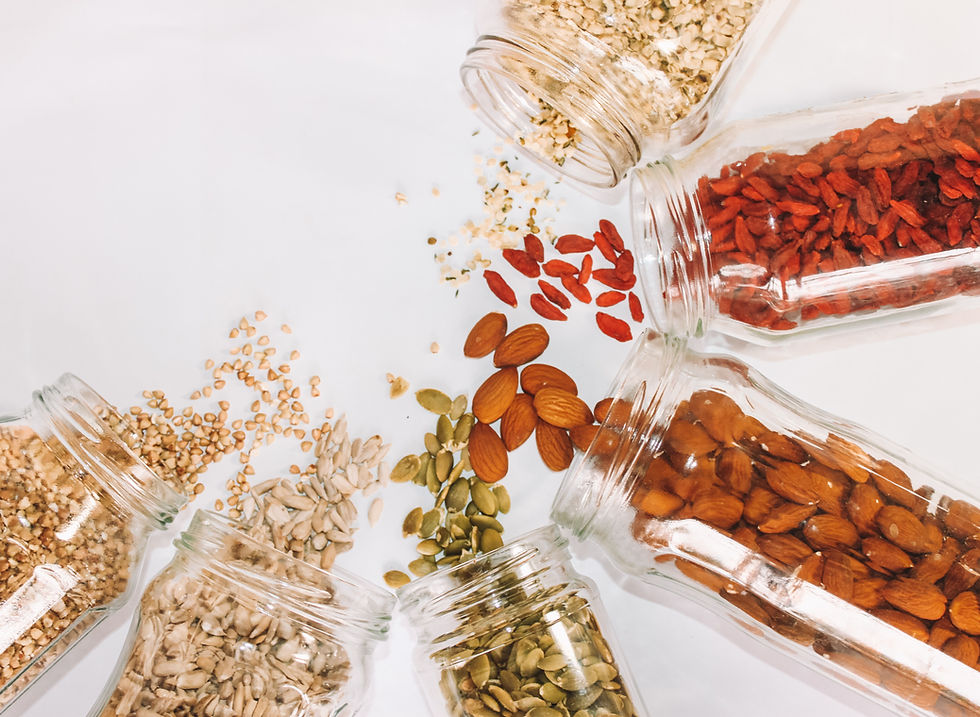Are fats bad for you?
- Blanka
- Jun 25, 2023
- 3 min read
Updated: Jul 10, 2023

The information about the different types of fats can be confusing. So, what are fats, do we need to be cautious about our fat intake, and how much do we need to consume?
What are fats?
Fats are also called lipids or fatty acids. On a molecular level, fats comprise three hydrocarbons and a glycerol molecule. Fats contain 9 kcal per gram, making them the major energy source in the body (carbohydrates contain 4 kcal per gram). The main types of fats are saturated, unsaturated, and trans fats; within unsaturated fats are monounsaturated and polyunsaturated fatty acids. In short, it is essential that we include fats in our diet.
Why do we need fats?
Fats have vital functions in the human body, such as protecting our organs, insulate and store energy. Fat is also required for all fat-soluble vitamins, namely A, D, E, and K, for absorption and storage in the liver and fatty tissues. Moreover, fats are vital in producing important hormones. For example, good cholesterol (high-density lipoprotein) is the precursor of progesterone, estrogen, and testosterone, and the fat we consume supports cholesterol production.
Saturated fat

Saturated fats are solid both at room temperature and refrigerated. This type of fat includes butter, lard, coconut oil, tallow, and cottonseed oil. Products high in saturated fats include dairy products such as cheese, cream, whole milk products, and ice cream, as well as fatty meat products such as chicken thighs and red meat. Consuming saturated fats daily is part of a healthy, balanced diet; however, we want to watch our intake of this fat.
Although recent reviews debate the effects of saturated fat on health, high intakes are still thought to contribute to cardiovascular diseases, so it is best to consume within the recommended daily amount, which is no more than 20 g per day for adult women and 30 grams for adult men.
Unsaturated fat

Unlike saturated fat, unsaturated remains liquid at room temperature and in the fridge. This type of fat benefits our health and their consumption is greatly encouraged. Unsaturated fats can help lower inflammation and cholesterol levels and support heart health. Examples of monounsaturated fatty acids include almonds, hazelnut, avocado, pumpkin seeds, and olive oil, whilst polyunsaturated fatty acids can be found in flaxseed, walnut, sunflowers, and certain fish.
The polyunsaturated fat found in certain fish, such as salmon, mackerel, and sardines, contain omega-3 fatty acids; hence, the guidelines on two portions of oily fish consumption per week. We must consume omega-3 since our bodies cannot make this type of fat. Consuming flaxseeds and walnuts will also help get in your omega-3s if you are vegan or vegetarian. However, it is often recommended to corporate an algae-based omega-3 supplement if you don't include fish in your diet.
Omega-6 is another essential polyunsaturated fatty acid our bodies cannot make. Almonds, cashews, walnuts, rapeseed, and sunflower oils are all contributing towards your omega-6 intake.
Since both mono and polyunsaturated fats are beneficial to our health, there is no warning against a daily limit; however, it is essential to remember that whilst it’s good for us, excess fat will be turned into fat in our bodies, so it still should be consumed in moderation.
Trans fats

Another important type of fat to mention is trans fats. It is best to limit this kind of fat as much as possible; daily consumption is recommended to be kept below 5 grams daily for adults. Trans fats are partially hydrogenated vegetable oils in fried foods, margarine, and many baked goods you find on the self. Higher consumption of trans fats increases the risk of heart disease, and inflammation in the body, and raises bad cholesterol.
Some easy tips to reduce trans and saturated fats and increase unsaturated fats in our diet:
Choose lean meat such as chicken or turkey breast instead of thighs and mince
Limit red meat consumption
Use oils such as olive oil and sunflower oil for cooking instead of butter and coconut oil
When you can, opt for low-fat dairy products, or incorporate more plant-based alternatives
Snack on nuts and seeds instead of store-bought biscuits
Whilst cakes, doughnuts, takeaways, and fried foods can be part of your diet occasionally, get into the habit of making food at home as this way, you limit your trans fat intake significantly
Resources
Harvard School of Public Health (2018). Types of Fat. [online] The Nutrition Source. Available at: https://www.hsph.harvard.edu/nutritionsource/what-should-you-eat/fats-and-cholesterol/types-of-fat/.
Khan Academy (2018). Lipids. (online) Khan Academy. Available at: https://www.khanacademy.org/science/biology/macromolecules/lipids/a/lipids.
NHS (2022). How to eat less saturated fat - NHS. (online) nhs.uk. Available at: https://www.nhs.uk/live-well/eat-well/how-to-eat-a-balanced-diet/eat-less-saturated-fat/.
NHS (2023). Facts about fat. (online) nhs.uk. Available at: https://www.nhs.uk/live-well/eat-well/food-types/different-fats-nutrition/.
Sebley, C. and Cymet, . Tyler (2016). saturated fat. Encyclopedia Britannica. https://www.britannica.com/science/saturated-fat
Valk, R., Hammill, J. and Grip, J. (2022). Saturated fat: villain and bogeyman in the development of cardiovascular disease? European Journal of Preventive Cardiology, 29(18). doi:https://doi.org/10.1093/eurjpc/zwac194.


